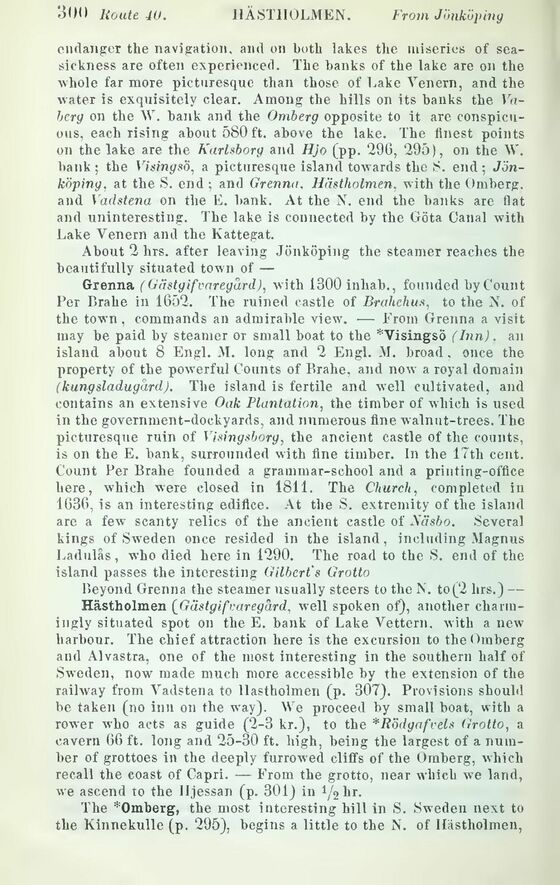
Full resolution (JPEG) - On this page / på denna sida - Sweden - Pages ...

<< prev. page << föreg. sida << >> nästa sida >> next page >>
Below is the raw OCR text
from the above scanned image.
Do you see an error? Proofread the page now!
Här nedan syns maskintolkade texten från faksimilbilden ovan.
Ser du något fel? Korrekturläs sidan nu!
This page has never been proofread. / Denna sida har aldrig korrekturlästs.
endanger the navigation, and on both lakes the miseries of
seasickness are often experienced. The hanks of the lake are on the
■whole far more picturesque than those of Lake Yenern, and the
water is exquisitely clear. Among the hills on its banks the
Vaberg on the W. hank and the Omberg opposite to it are
conspicuous, each rising about 5S0 ft. above the lake. The finest points
on the lake are the Karlsborg and Hjo (pp. 296, 295), on the W.
bank ; the Visingsö, a picturesque island towards the S. end ;
Jönköping, at the S. end; and Grenna, Hästholmen, with the Omberg,
and Vadstena on the E. bank. At the N. end the banks are flat
and uninteresting. The lake is connected by the Göta Canal with
Lake Yenern and the Kattegat.
About 2 hrs. after leaving Jönköping the steamer reaches the
beautifully situated town of —
Grenna (Gästgifvaregård), with 1300inhab., founded by Count
Per Brahe in 1652. The ruined castle of Brahehus, to the N. of
the town, commands an admirable view. — From Grenna a visit
may be paid by steamer or small boat to the *Visingsö (Inn), an
island about 8 Engl. M. long and 2 Engl. M. broad, once the
property of the powerful Counts of Brahe, and now a royal domain
(kungsladugård). The island is fertile and well cultivated, and
contains an extensive Oak Plantation, the timber of which is used
in the government-dockyards, and numerous fine walnut-trees. The
picturesque ruin of Visingsborg, the ancient castle of the counts,
is on the E. bank, surrounded with fine timber. In the 17th cent.
Count Per Brahe founded a grammar-school and a printing-office
here, which were closed in 1811. The Church, completed in
1636, is an interesting edifice. At the S. extremity of the island
are a few scanty relics of the ancient castle of Xäsbo. Several
kings of Sweden once resided in the island, including Magnus
Ladulås, who died here in 1290. The road to the S. end of the
island passes the interesting Gilbert’s Grotto
Beyond Grenna the steamer usually steers to the N. to(2 hrs.) —
Hästholmen [Gästgifvaregård, well spoken of), another
charmingly situated spot on the E. bank of Lake Vettern. with a new
harbour. The chief attraction here is the excursion to the Omberg
and Alvastra, one of the most interesting in the southern half of
Sweden, now made much more accessible by the extension of the
railway from Yadstena to Hästholmen (p. 307). Provisions should
be taken (no inn on the way). We proceed by small boat, with a
rower who acts as guide (2-3 kr.), to the *Rödyafcels Grotto, a
cavern 66 ft. long and 25-30 ft. high, being the largest of a
number of grottoes in the deeply furrowed cliffs of the Omberg, which
recall the coast of Capri. — From the grotto, near which we land,
we ascend to the Hjessan (p. 301) in i/2hr.
The *Omberg, the most interesting hill in S. Sweden next to
the Kinnekulle (p. 295), begins a little to the N. of Hästholmen,
<< prev. page << föreg. sida << >> nästa sida >> next page >>